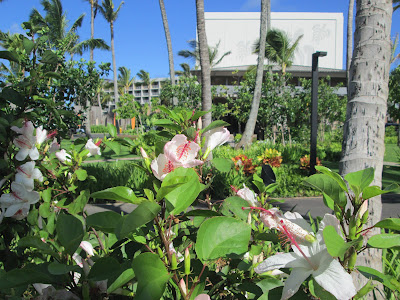Golden Duranta seemed to suddenly become popular in the gardens of Hawaii a few decades ago. I also saw it suddenly spread around the islands of Samoa within just a few years. Its bright yellow foliage and ease of propagation made it quickly popular amongst gardeners. This shrub/small tree is native to tropical Central and South America and grows there in hot, sunny, sandy areas so we can be sure it is another tough plant.
 |
Golden Duranta grown as a trimmed hedge/groundcover
along with Spider Lilies. |
In our area of Oahu, Golden Duranta is usually seen in the form of low, long, formal hedging to contain a garden of shrubbery. Occasionally you see low shrubs that have been shaped into a large ball. It looks great but you have got to know that it takes a ground crew to regularly trim them with a powered hedge trimmer to keep them looking so nice. Many viewers do not realize that that low, under 2 ft, hedge plant is actually a huge bush if you let it grow naturally.

If you buy a plant and put it out in your garden you will realize how quickly Golden Duranta grows. If you are wanting a shaped plant, you need to start pinching tips and keep those clippers on hand. You could let it grow out naturally but be prepared for a fast-growing bush that is as wide as it is high and may need some hard pruning every few years. What is beautiful is to shape it into a small tree. (Fifteen feet or so high.) Select one or three of the main stems to become the trunk and prune away anything extra under the crown. As the tree grows higher you will have a beautiful weeping form tree that really shows of the flower and berry spays at their best. You can also make a mini version of this by shaping a plant in a pot into a standard.....one tall stem with a big bushy head on top. In Samoa I have also seen tall plants being shaped into topiary animals that make fun entrances to the house.

The Golden Duranta has beautiful sprays of small flowers that show up all year round. They are usually blue in color but you do see white and purple varieties as well. The flower spray then turns into a spray of small golden berries that are also very pretty. Both could be included in a small flower arrangement, but I think the berries last longer. The flowers only form on new growth so if you are frequently trimming the shrub, you are not going to see them.
You do need to know that the fruit and the leaves of Golden Duranta is poisonous so you may not want to grow this plant in your garden if you have small children or pets. For some reason it does not seem to affect birds.
 |
A shrub that has been allowed to just grow naturally
with occasional trim. |
Golden Duranta likes full sun and moist but well drained soil. It grows very fast and naturally sprawls out so keep that in mind as you choose where to plant it. You would not want it right next to a walkway. The mature plant does have tiny thorns (or bigger ones on a tree) so that could be a problem. On the other hand, this makes it a good shrub to keep people out of certain areas.
White fly can sometimes be a problem and spraying with soapy water can help this. If you are growing Golden Duranta into a hedge it is always important to shape the hedge so that it is narrower on top so that all the leaves get access to the sun for good foliage growth.
It is fairly easy to propagate Golden Duranta from cuttings. Start off 6" lengths of woody stem tips in potting media. Using rooting hormone will give some extra help. It can also be propagated from seed.
Aloha




















































